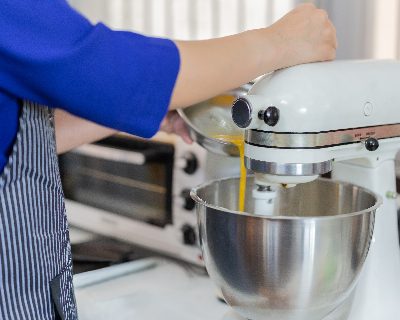| Is a Stand Mixer Better for Kneading Bread Dough? |  |
Here you'll also learn how to mix and knead dough using a stand mixer with a dough hook and even how to convert your own favorite hand-kneaded yeast bread to mixing and kneading with your mixer. C'mon, bread bakers, let's get floured up!
A Practical Look at Kneading Bread Dough with a Stand Mixer.
Seven Good Reasons to Knead Bread Dough with a Stand Mixer.
In my kitchen, there are several reasons to use a mixer for kneading dough. I'd love to know why you're kneading bread with a stand mixer. Please do let me know!
- That Kitchen Aid color you chose is so pretty, just seeing it on the counter makes you happy! Am I right?!
- A stand mixer removes much of the guesswork and judgment for kneading bread.
- A stand mixer yields consistent results, every time.
- A stand mixer saves about 10 minutes of hands-on time for kneading.
- A stand mixer leaves no sticky, floury mess on the counter.
- A stand mixer is easier for bakers with arthritis in their hands.
- A stand mixer "will usually produce better dough than hand kneading".
Really? Better Bread Dough?

Yes! Or at least so says Andrew Whitley, author of Bread Matters: The State of Modern Bread and a Definitive Guide to Baking Your Own (affiliate link).
Not only does Whitley's book make eye-opening statements like that, it's also a damnation of the state of bread at least in the United Kingdom and at least in the 2009 year of publication. It's a fascinating look at how the flours and yeasts that go into even homemade bread but especially store-bought and fast-food breads have been modified. Are the changes the reason for the increases in wheat sensitivity in the last two decades? Perhaps.
But for me, the book's most challenging practical take-away was this:
Whitley: "A stand mixer with a dough hook kneads bread dough better than hand-kneading."

Seven Good Reasons to Knead Bread Dough by Hand.
Granted, I have an emotional attachment to kneading bread, it's all intertwined with my mom's breast cancer at age 35. She was a survivor and homemade bread helped her recover.
But I also have this back-to-nature, old-ways-are-better and who-needs-kitchen-appliances mentality that leans toward DIY bread dough.
- A stand mixer is heavy, bulky and expensive. It takes up so much room on the counter!
- Kneading bread dough takes about 10 minutes, a time for contemplation, mentally preparing for the day, listening to kids chatter at the table, a brief respite from the concerns of the day.
- Kneading helps bakers learn to feel the dough through their hands, really understanding how the yeast is working, whether the dough is a little loose or a little stiff.
- Bread kneaded by hand can rise faster, thanks to the warmth of your hands working the dough.
- Kneading bread dough is a good upper-arm workout!
- Kneading bread can be done anywhere, anyplace, in any kitchen.
- Bread dough kneaded by hand rises a little faster, sometimes much faster.
Why Must Yeast Breads Be Kneaded In the First Place?
You might have heard about the famous "No Knead" bread revolution. It started with a New York baker named Jim Lahey and spread like wildfire. People l-o-v-e that bread.
Trouble is, arrrgh, no-knead bread takes tricky timing, it takes a mathematician to figure out when to start the bread today in order to bake it for dinner tomorrow. And the dough is super-wet, it takes real wrangling.
And the reason the bread turns out well is thanks to the slow-rise not the lack of kneading. If you've ever let bread rise in the refrigerator? That's the slow rise that develops flavor. (Want to know more? See Time Is on Your Side at Slate.com.)
Because with no-knead bread, time allows the flour's gluten to develop.
For most yeast breads, kneading allows the gluten in the flour to develop. And it's gluten's stringy strands of protein that give yeast breads their strength and very texture.
So we knead bread dough to, well, at its very essence, to create the very bread we love and revere.
WHAT ABOUT QUICK BREADS? An aside: What we call "quick breads" (like pumpkin bread or banana bread or cornbread or muffins) are leavened with baking powder and/or baking soda, not yeast. With quick breads, we don't want the gluten to develop in quite the same way.
Stand Mixer Tips
Will a Hand Mixer Work for Kneading Bread Dough? I'm not sure. I'm thinking not because as the yeast begins to activate, the dough would become heavy and unmanageable and could easily burn up the small motor. That said, this list of mixers from Good Housekeeping claims that two hand mixers each under $100 come with bread hooks and manage dough well.
Do You Need a Dough Hook? Yes. A stand mixer comes with a special paddle called a dough hook that creates a particular action that kinda man-handles the dough. (Don't have one? A dough hook costs about $15 and takes up little room. I got my last Kitchen Aid dough hook (affiliate link) on Amazon but do be aware, the hooks vary by model so you'll want to match up with your own machine before ordering.
Do You Have to Mix Bread Dough with a Mixer? Absolutely not. None of my bread recipes call for a stand mixer. And to my mind, there's a tactile pleasure in working bread dough by hand, feeling the yeast begin to activate and the dough move from distinct individual ingredients to a firm, cohesive and unified dough.
What If the Bread Dough Flops All Over? You definitely don't want the dough coming out of the mixer! There are a couple of ways to prevent this.
First, run the mixer on the very lowest setting.
Two, avoid adding too much flour, especially when adding the extra flour a tablespoon at a time to compensate for the flour which otherwise would be kneaded in by hand.
But if the dough still pops out, stop the mixer and use a knife to pull the dough off the dough hook back into the bottom of the bowl.
Start the mixer again and if that fixes things, great.
If not, stop the mixer again and pull out the dough and with your hands, break it up into a dozen pieces or so; put these back into the bottom of the mixer and try again. If this doesn't work, your dough may be a little dry. Try adding liquid a teaspoon at a time until the dough becomes more workable and stays in place inside the bowl.
More Questions? Just ask and I'll do my best to answer!
How to Convert a Bread Recipe from Hand-Kneading to a Stand Mixer
If you have a bread recipe you love, can it be converted to kneading with a stand mixer? Yes! Here's the process I follow. In fact, I used it to convert My Easy Everyday Bread Recipe into Easy Everyday Bread for the Stand Mixer!
- Use all the same ingredients. Use all the same amounts too, save flour, you'll likely need to add flour to compensate for what gets worked in while hand-kneading.
- Change the order of the ingredients, dry ingredients first, wet ingredients second.
- If using dry yeast, add it with with dry ingredients. If proofing the yeast in a little water or other liquid, add it with the wet ingredients.
- Stir the dry ingredients together before adding the wet ingredients. To avoid flour flying all over, before turning on the mixer, stir the dry and wet ingredients together with a spatula just enough to wet the flour a bit.
- With the dough hook in place, turn on the mixer on low. While the mixer runs for 2 minutes, you're going to add some flour, the flour that would normally be worked in when kneading by hand. Add the flour a tablespoon at a time into the bottom of the bowl (drop it in from above so there's no risk of getting tangled up with the hook).
- You've added enough flour when the dough collects up all the wet/floury bits in the bottom of the bowl and pulls away from the sides, forming a single, odd-shaped blob that moves and reshapes as the dough hook turns. Add only as much flour as needed, otherwise, the bread will turn out heavier than desired and will have more calories.
- For those who take notes, "fix" on how much flour to add the next time right from the get-go by first measuring out an extra cup of flour, 125g, then re-measuring once you've added the right amount tablespoon by tablespoon for this particular dough.
- Run the mixer for another 5 or 6 minutes, for a total of 7 or 8 minutes. The dough should be firm and full and it might be a little stickier than hand-kneaded dough.
- Turn the dough out onto a lightly floured surface and knead by hand for a minute or two, this makes it easier to shape the dough for the first rise.
- That's it! Now that the bread has been kneaded, continue to follow the instructions for letting the dough rise, shaping the dough, letting the dough rise again and then baking and cooling. All that's just the same!
More Provocative Kitchen Questions
~ Ripe Bananas for Baking: How Ripe Should Bananas Be?~~ Should Cooked Pork Be Pink? ~
from Kitchen Parade
~ Never Buy Fresh Herbs Again ~
~ Never Buy Salad Dressing Again~
from A Veggie Venture, my food blog about vegetables
© Copyright Kitchen Parade
2020 & 2023










Lahey didn’t invent no knead dough. What a ridiculous claim. He wrote a book about it, period.
ReplyDeleteThat's funny, who said that Jim Lahey invented no-knead dough? Not me. But he sure did popularize it, creating a world-wide bread-baking phenomenon. Perhaps we might agree on that count? ~ Alanna
Delete